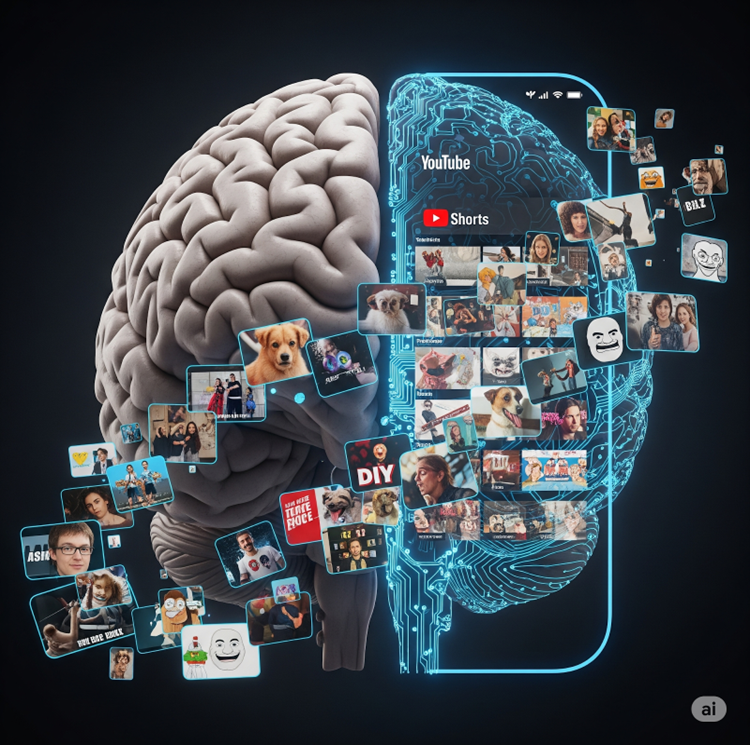You open YouTube Shorts while waiting for your coffee. A couple of videos, you think. Thirty minutes later, you're still scrolling. The brain is buzzing, time is gone.
YouTube Shorts isn't just a feature; it's a behavioral machine. Designed for instant engagement, its algorithm learns fast and adapts even faster. The more you watch, the better it knows what to show next.
This endless dopamine loop is no accident—it's psychology, code, and location-based data working together. In this article, we'll describe the algorithm more and a way to decode how Shorts changes based on who and where you are.

The Engine Behind the Scroll
Ever wonder why that video showed up on your Shorts feed? It's not random. You swipe, and the algorithm learns.
YouTube runs one of the largest and most sophisticated recommendation engines in the digital world. At its core are two AI models: a deep candidate generation model, which picks a pool of potentially interesting videos, and a deep ranking model, which decides which ones to serve you first, and in what order.
And if YouTube wasn't already addictive enough, it introduced Shorts—its answer to TikTok and Instagram Reels. These vertical, snackable videos, up to 60 seconds long, are designed for frictionless consumption. Unlike traditional YouTube content that relies on keywords, tags, and SEO to gain visibility, Shorts run on a different kind of fuel: user behavior.
The algorithm behind Shorts doesn't guess what you might like. It learns what keeps you scrolling and optimizes for it in real time. Its mission? Keep you watching, keep you hooked, and keep you coming back.
Your Brain vs. The Algorithm
Attention engineering is not new, but AI has made it incredibly effective. Every user must understand that many social media platforms don't care about the content itself; they want you to spend as much time as possible on their apps.
One powerful method they use is variable rewards. Unlike predictable feedback, variable rewards deliver unpredictable bursts of excitement, which keep you hooked. Because checking social media takes very little effort, this unpredictability makes you check your phone repeatedly, hoping for a "hit" of enjoyment.
Social media addiction is real. While most of us aren't fully addicted, many of our behaviors mimic addiction. For example, after posting something, we often find ourselves repeatedly checking how many likes or reactions we've received. This creates a feedback loop that repeats with every new post, keeping us engaged and craving more validation.
The effects aren't just about wasting time. Prolonged use can increase anxiety, lower self-esteem, and create a psychological dependence on your device. The fear of missing out, or FoMO, keeps many users compulsively checking their feeds, even when they'd rather not. Ironically, this constant digital engagement can leave people feeling more isolated and less social in real life.
The algorithm is designed to trap your attention, but knowing how it works empowers you to resist.
Why Your Feed Is Different From Everyone Else's
Your Shorts feed is shaped by more than just what you like. YouTube personalizes it based on your geolocation, language settings, the device or browser you're using, and your watch history. That's why two people sitting next to each other might see completely different videos.
Try comparing feeds in different countries, like the US or Japan. For example, a user in the US might see trending dance challenges, political commentary, or product reviews, while someone in Japan could be served anime clips, local music trends, or street food content. Even if you search the same keyword, the results and suggestions can look entirely different because YouTube tailors content to what's popular and culturally relevant in your region. This leads to personalized streams of content that reflect local trends but also restrict exposure to broader, global perspectives.
You can test proxies to understand your feed better. They are for anyone who wants to see how their content is filtered, shaped, and delivered. The more you know, the more control you have.
Welcome to the Bubble: Personalization or Propaganda?
YouTube Shorts promises highly personalized content. And that sounds great until personalization starts to feel like manipulation. Why are we comparing it to propaganda? Because when an algorithm shows you what it thinks you want to see, over and over, it can shape your preferences, your mood, even your worldview without you realizing it.
The YouTube Shorts algorithm creates a feedback loop: you watch → it learns → it shows you more of the same. Over time, this creates a narrow lens or your own little digital bubble. For some, it's harmless fun. But for others, it can mean exposure to repetitive content, extreme viewpoints, or just a limited version of reality.
Creators are trying to win in a system where every second counts. To improve their reach, many analyze metrics like watch time, click-through rate, and engagement. But here's the twist—algorithms don't behave the same everywhere. That's why each creator should think of residential proxies. By simulating various geolocations or behaviors, creators can understand how their content performs across audiences. It's a way to test how personalization affects distribution.
On the viewer side, every action feeds the algorithm. What you watch, how long you watch it, and whether you swipe away or rewatch, shape what comes next. If you want more control over your feed or want to see how recommendations shift across countries or devices, proxies let you explore YouTube Shorts through a different lens. It's a way to see what the platform might not usually show you.
Don't just scroll passively. Try these ways to see past the algorithm:
- Use incognito mode and proxies to access Shorts from different regions. See what's trending elsewhere.
- Clear your watch history regularly to reset recommendations.
- Search manually for topics outside your usual interests to retrain the algorithm.
- Be intentional with your engagement. Skip what bores you, choose content that surprises you.
Conclusion
Social media wasn't built just for fun or connection; it's a system carefully engineered to keep you scrolling. Be more aware of how your time is spent online, question what you see, and take back control. Use it to connect with people you care about or discover new perspectives. And if you're curious about how platforms shape your experience, use tools like reliable proxy providers to broaden your view and build real connections.
ⓒ 2026 TECHTIMES.com All rights reserved. Do not reproduce without permission.





